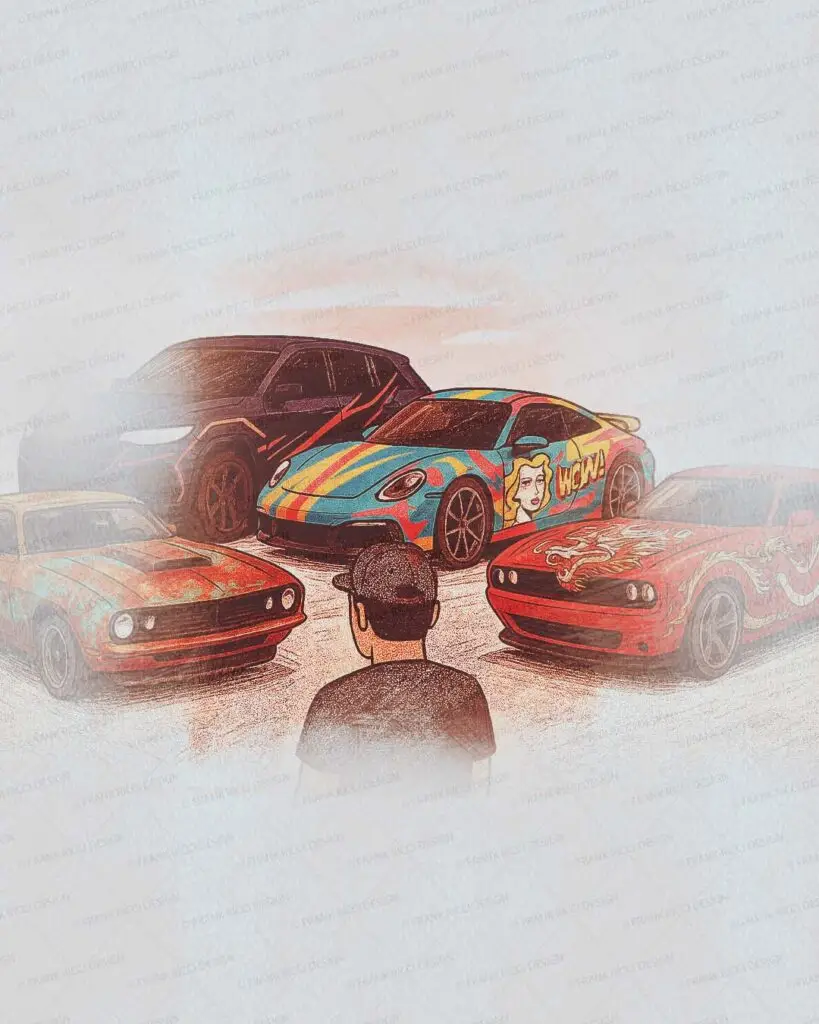Understanding Graphic Styles in Car Wrap Design

Wrap design goes far beyond simply covering a vehicle—it’s about expressing identity, attitude, and purpose through visual language.
Over the years, different graphic styles have evolved, giving rise to what we can now call real “schools of thought” in wrap design. In this article, we’ll explore the main styles in a summarized way, offering a practical overview of the most recognized graphic directions used in vehicle wrapping.
1. The Racing School: The Origin of Wrap Design
The earliest and most recognizable style comes from the world of motorsports. Racing wraps follow their own rules: high contrast, visible sponsors, numbers, and technical layouts.
These visuals are built for impact and readability at high speed. It’s from this world that the tuning scene adopted and reinterpreted wrap design, taking it beyond the track.
2. Commercial and Brand-Oriented Styles
When it comes to business vehicles, graphic style reflects brand identity. Here we find two major mindsets among company owners:
- “I want something special, but discreet.”
- “I want to be noticed.”
As an experienced designer, I know both directions can lead to high-quality, exclusive results. The real problem comes when discretion is driven by fear of exposure or when boldness is chosen with a superficial approach. In both cases, understanding the brand’s true personality is the key to a successful design.
3. Show Cars and Passion Projects
Show cars, whether linked to a brand or owned by car guys participating in meets and rallies, allow for a wider creative playground.
These designs range from ultra-minimal to wildly expressive, depending entirely on the mindset of the owner. The variety of styles used in show cars reflects the diversity of the people behind them.
4. Track Toys and Collectors
These are vehicles used on track days or in amateur rallies—built and modified out of pure passion by private owners. Wrap styles on these cars often reflect a blend of performance and personality.
Alongside these are collectors, both active and passive. Active collectors have multiple cars—often over 20 years old—maintained in perfect condition and proudly displayed at gatherings and classic car events. Their wraps tend to preserve authenticity or add a touch of refinement without compromising the vehicle’s heritage.
5. An Expanding Universe of Styles
With the explosion of wrap culture, styles have multiplied. Some are rooted in traditional graphic design or automotive visual culture; others are entirely new, born from experimentation and innovation.
Emerging and evolving styles include:
- Sketch Style: Makes the car look hand-drawn with markers, playful yet precise.
- Cartoon Style: Stylized and bold, often exaggerating forms and outlines for a comic or manga-inspired look.
- Patina & Rusted Look: Mimics wear, rust, and aged materials for an aggressive vintage feel.
- Evocative/Tribute Designs: Inspired by movies, sports teams, artists, and pop culture references—half homage, half personal expression.
In addition to wrap-specific trends, many styles borrow from or reinterpret well-known artistic movements and visual cultures, such as:
- Pop Art: High-contrast graphics, bold colors, and iconography.
- Minimalism: Clean, uncluttered compositions with a focus on form and color.
- Graffiti & Street Art: Expressive, urban, and full of texture and layering.
- Futurism & Cyberpunk: Techno-inspired aesthetics with glowing effects, circuits, or digital motifs.
- Baroque & Ornamental: Rich in decoration, gold accents, and historic flourishes.
These styles are not just about looks—they shape how the car is perceived and how the owner expresses themselves. The more the design community experiments, the more new hybrid styles emerge, constantly evolving the visual language of vehicle wrapping.
6. The Role of Inspiration and Observation
Inspiration can come from anything around us—it all depends on whether we notice it and feel something from it. But if we’re distracted or unfocused, we might miss the spark. When we look at someone else’s wrap design online, we might see different things depending on our own perspective.
For example, if you’re going for an illustrated urban style, you might find inspiration in modern street art paintings. If you’re after a sporty theme, consider looking at aviation liveries or design styles from other competitive sports teams. If you’re thinking about a patina-style wrap, vintage photos or images of decaying architecture can provide great texture references. If you want something vibrant and colorful, explore streetwear fashion—both current trends and specific subcultures.
For brands and companies, inspiration often starts from within: the industry itself and how top-tier competitors present themselves. Even product packaging can offer visual cues. The key is to observe critically and with a creative mindset—turning the world around you into a moodboard of ideas.
7. Choosing the Right Style
Different owners and brands require different graphic languages. Understanding their background, goals, and values is essential to propose a style that fits. There is no one-size-fits-all in wrap design. The goal is always the same: to create something memorable, coherent, and true to the person or company behind the vehicle.
Whether you’re into racing aesthetics, brand representation, or full-blown creative expression, there’s a graphic style out there that can speak for you. The challenge is choosing the one that tells your story best.
Want to know more about how a graphic becomes a wrap? Listen to our podcast Under the Wrap Design, where we dive deep into the creative process, challenges, and real-world decisions behind each project.
Ready to bring your wrap project to life?
Want to explore How to Choose the Right Wrap Design for Your Vehicle? Click here ⧉
